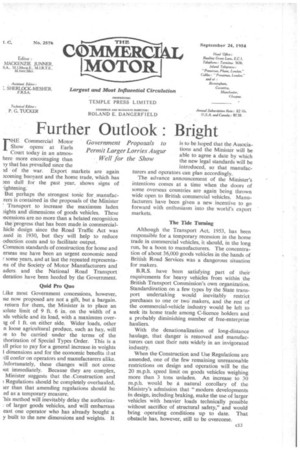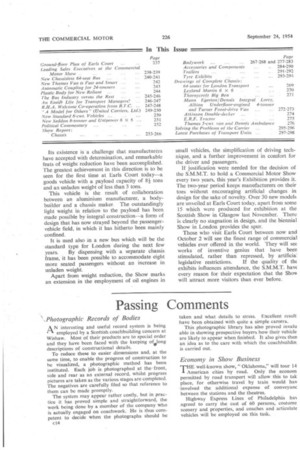Further Outlook : Bright
Page 79

Page 80

If you've noticed an error in this article please click here to report it so we can fix it.
• Government Proposals to Permit Larger Lorries Augur Well for the Show
THE Commercial Motor Show opens at Earls Court today in an atmoshere more encouraging than iy that has prevailed since the id of the war. Export markets are again !corning buoyant and the home trade, which has :en dull for the past year, shows signs of -ightening.
But perhaps the strongest tonic for manufacrers is contained in the proposals of the Minister Transport to increase the maximum laden tights and dimensions of goods vehicles. These incessions are no more than a belated recognition the progress that has been made in commercialhide design since the Road Traffic Act was ssed in 1930, but they will help to reduce oduction costs and to facilitate output.
Common standards of construction for home and erseas use have been an urgent economic need 7 some years, and at last the repeated representans of the Society of Motor Manufacturers and aders and the National Road Transport deration have been heeded by the Government.
Quid Pro Quo Like most Government concessions, however, )se now proposed are not a gift, but a bargain. return for them, the Minister is to place an 3o1ute limit of 9 ft. 6 in. on the width of a xis vehicle and its load, with a maximum overig of 1 ft. on either side. Wider loads, other n loose agricultural produce, such as hay, will re to be carried under the terms of the thorization of Special Types Order. This is a ill price to pay for a general increase in weights I dimensions and for the economic benefits that till confer on operators and manufacturers alike. Jnfortunately, these changes will not come )ut immediately. Because they are complex. Minister suggests that the .Construction and Regulations should be completely overhauled, ter than that amending regulations should be ed as a temporary measure.
'his method will inevitably delay the authorizaof larger goods vehicles, and will embarrass east one operator who has already bought a y built to the new dimensions and weights. It is to be hoped that the Associations and the Minister will be able to agree a date by which the new legal standards will be introduced, so that manufacturers and operators can plan accordingly.
The advance announcement of the Minister's intentions comes at a time when the doors of some overseas countries are again being thrown wide open to British commercial vehicles. Manufacturers have been given a new incentive to go forward with enthusiasm into the world's export markets.
The Tide Turning Although the Transport Act, 1953, has been responsible for a temporary recession in the home trade in commercial vehicles, it should, in the long run, be a boon to manufacturers. The concentration of about 36,000 goods vehicles in the hands of British Road Services was a dangerous situation for makers.
B.R.S. have been satisfying part of their requirements for heavy vehicles from within the British Transport Commission's own organization. Standardization on a few types by the State transport undertaking would inevitably restrict purchases to one or two makers, and the rest of the commercial-vehicle industry would be left to seek its home trade among C-licence holders and a probably diminishing number of free-enterprise hauliers.
With the denationalization of long-distance haulage, that danger is removed and manufacturers can cast their nets widely in an invigorated industry.
When the Construction and Use Regulations are amended, one of the few remaining unreasonable restrictions on design and operation will be the 20 m.p.h. speed limit on goods vehicles weighing more than 3 tons unladen. An increase to 30 m.p.h. would be a natural corollary of the Ministry's admission that "modern developments in design, including braking, make the use of larger vehicles with heavier loads technically possible without sacrifice of structural safety," and would bring operating conditions up to date. That obstacle has, however, still to be overcome. Its existence is a challenge that manufacturers have accepted with determination, and remarkable feats of weight reduction have been accomplished. The greatest achievement in this direction is to be seen for the first time at Earls Court today--a goods vehicle with a payload capacity of 81 tons and an unladen weight of less than 3 tons.
This vehicle is the result of collaboration between an aluminium manufacturer, a bodybuilder and a chassis maker. The outstandingly light weight in relation to the payload has been made possible by integral construction--a form of design that has now strayed beyond the passengervehicle field, in which it has hitherto been mainly confined.
It is used also in a new bus which will be the standard type for London during the next few years. By dispensing with a separate chassis frame, it has been possible to accommodate eight more seated passengers without an increase in unladen weight.
Apart from weight reduction, the Show marks an extension in the employment of oil engines in small vehicles, the simplification of driving technique, and a further improvement in comfort for the driver and passengers.
If justification were needed for the decision of the S.M.M.T. to hold a Commercial Motor Show every two years, this year's Exhibition provides it. The two-year period keeps manufacturers on their toes without encouraging artificial changes in design for the sake of novelty. Over 30 new models are unveiled at Earls Court today, apart from some 15 which were produced for exhibition at the Scottish Show in Glasgow last November. There is clearly no stagnation in design, and the biennial Show in London provides the spur.
Those who visit Earls Court between now and October 2 will see the finest range of commercial vehicles ever offered in the world. They will see works of inventive genius that have been stimulated, rather than repressed, by artificial legislative restrictions. If the quality of thc exhibits influences attendance, the S.M.M.T. have every reason for their expectation that the Shom will attract more visitors than ever before.
























































































































































































































































































































